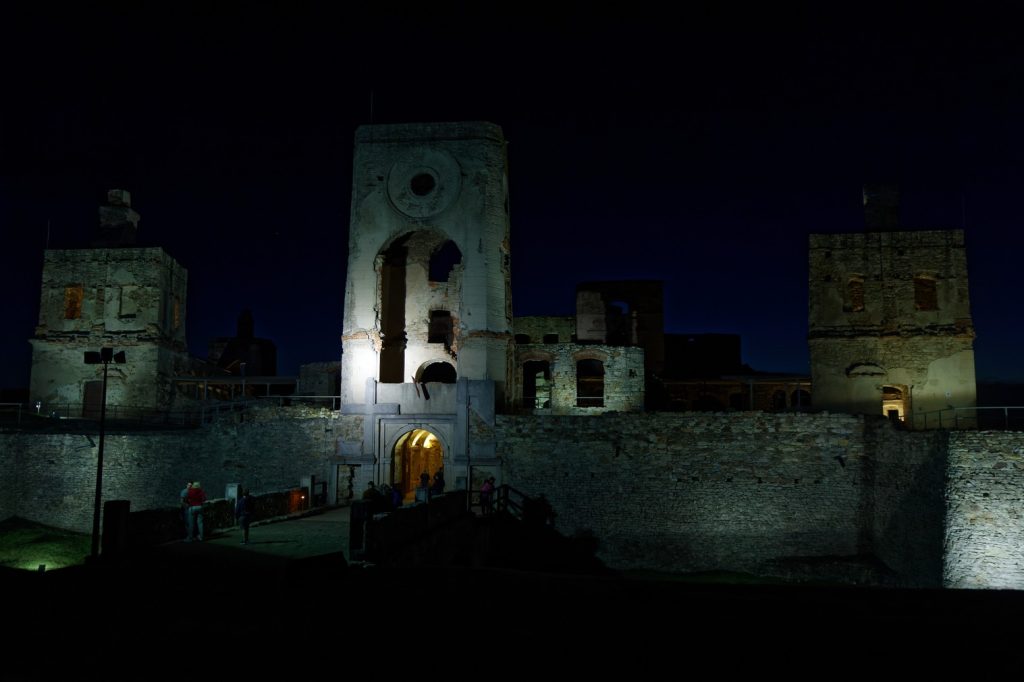Nestled in the quaint village of Ujazd, amidst the tranquil landscape of southern Poland, stands the majestic ruins of Krzyztopor Castle. This architectural marvel, once a symbol of grandeur and opulence, now tells tales of a glorious past, marked by the tides of time and history.

Why Krzyztopor
If you are wondering, what Krzyztopor means, you should be aware that the name seems a bit strange even for us, Poles. It consists of two words: Krzyz (meaning cross in English, a symbol of faith) and Topor (meaning axe in English, the Coat of Arms of Ossolinski family, the owners of the castle). The combination of those two words sounds strange, but the name of the castle resembles the castle itself. You may see both symbols at the entrance gate – cross on the left, axe on the right side.
History of Krzyztopor castle
Commissioned by the Polish nobleman and Voivode of Sandomierz, Krzysztof Ossolinski, the construction of Krzyztopor Castle commenced in the early 17th century. The exact inception date remains shrouded in mystery, but documented proof points towards the year 1627. The castle saw its completion in 1644, swallowing a fortune of 30 million Polish złotys in its wake. Despite the grand accomplishment, fate allowed Ossoliński just a fleeting moment of triumph, as death claimed him in 1645.
Symbolism in the castle
Krzyztopor Castle was not merely a dwelling but a colossal display of architectural ingenuity and a manifestation of Ossolinski’s fascination with symbolism and astrology. The castle’s layout mirrored a calendar, boasting 365 windows, 52 rooms, 12 halls, and 4 towers, representing the days, weeks, months, and seasons of a year, respectively. This unique design was not only an aesthetic triumph but also a reflection of Ossolinski’s philosophical inclinations.

Palazzo in Fortezza
The castle served as a fortified palace, encapsulated by robust bastion-type fortifications. It stood as the largest palace complex in Europe until the emergence of the illustrious Versailles. This “palazzo in Fortezza” was a statement of power and a fortress of solitude amid the political turmoil of the era
Luxury
Among its many lavish features, the castle housed underground stables adorned with crystal mirrors and marble troughs. The opulence extended to an upper floor hall, which boasted an exotic aquarium for a ceiling, alongside provisions of fresh running water in all rooms, dumb waiters, and a pioneering ventilation system, marking it as a groundbreaking property unique to Poland
The Siege and decline
Krzyżtopór’s grandiosity could not shield it from the ravages of war. During the Swedish invasion in 1655, the castle was seized and plundered, marking the beginning of its decline. Despite changing hands among noble families, the extensive damage from the siege deemed restoration unfeasible. The castle’s western wing housed some noble families but largely remained in ruins. The Russians furthered its ruin during the Bar Confederation in 1770. Attempts at restoration in the 20th century were short-lived, and the castle stands now as a monumental relic of a bygone era
Krzyztopor castle today
Today, the ruins of Krzyżtopor Castle stand as a silent testament to Poland’s rich historical tapestry. The castle’s remains, still echoing the grandeur of its past, beckon history enthusiasts and curious travelers to explore the whispers of history etched in its stone walls.
Krzyztopor Castle, with its unique architectural narrative and historical significance, continues to be a poignant landmark on Poland’s rich historical landscape, offering a glimpse into the lavish lifestyle of the Polish nobility and the relentless march of time that even the mightiest structures cannot withstand.
Visiting the castle
You may visit the castle during the day and night.
Day visit
Ticket for the day visit costs 20 PLN. You may visit the castle by yourself, or with the guide (+7 PLN). Unfortunately, the guide is not available on languages other than Polish.
There are 6 routes, but treat them as a suggestion rather than strict rule. You may cover all the routes during your visit.
The facility is open to the public during the following hours:
During the tourist season:
from April 1 to August 31 8:00am-8:00pm
from September 1 to October 31 8:00am-6:00
Out of tourist season:
from 1 November to 28 February 8:00-16:00
from 1 March to 31 March 8:00-18:00
Night visit
Night visit is only available with the guide. There are two options: Standard (40 PLN) or Premium (60 PLN). It should be reserved in advance. It is not available everyday, so check the schedule on the castle website.

Standard visit includes: guide service, illumination of the castle, tour with torches, meeting the ghost of the White Lady
Premium visit includes: guide service, illumination of the castle, torchlight tour, duelling demonstration by members of the Knights’ Brotherhood in the castle courtyard, court dance lessons by a noble couple, meeting with the White Lady’s ghost.
I strongly recommend both visits.
